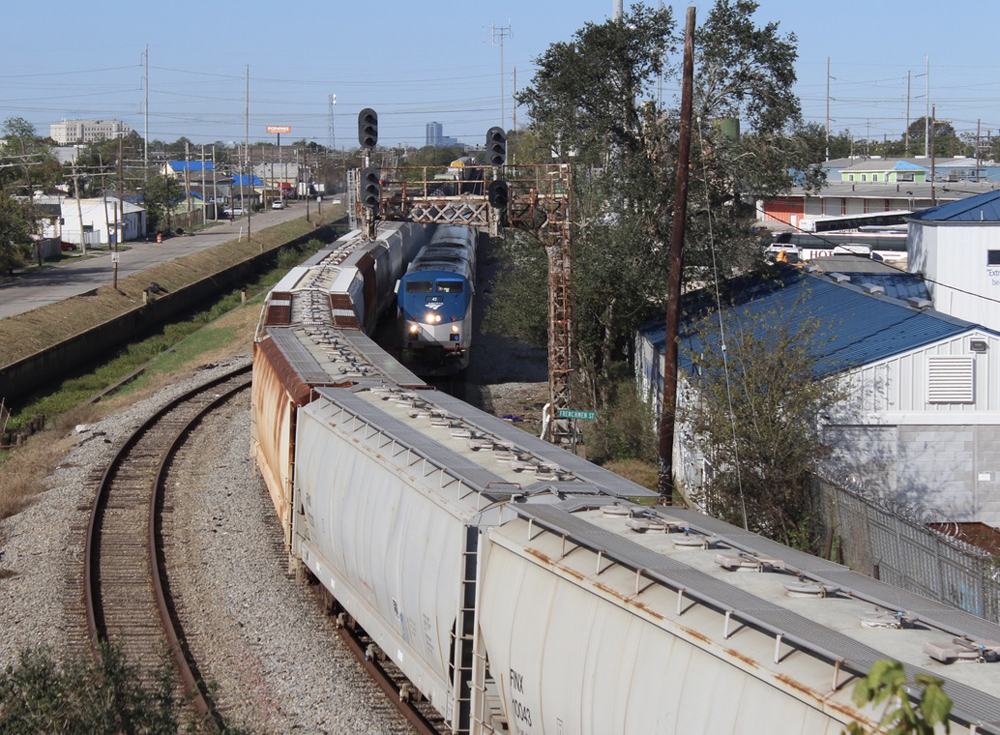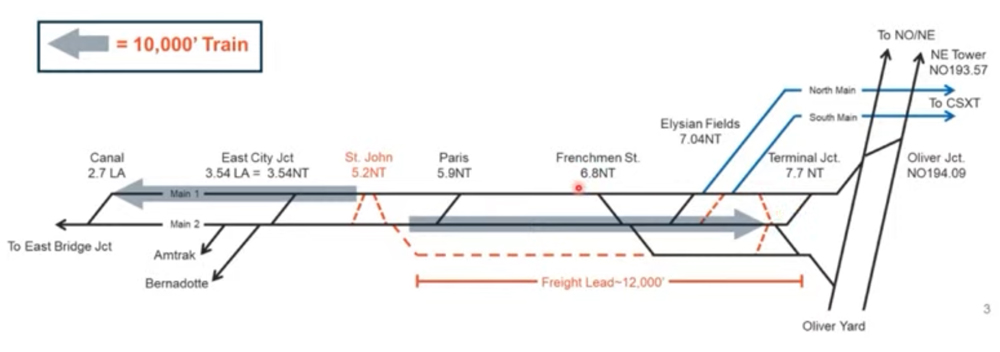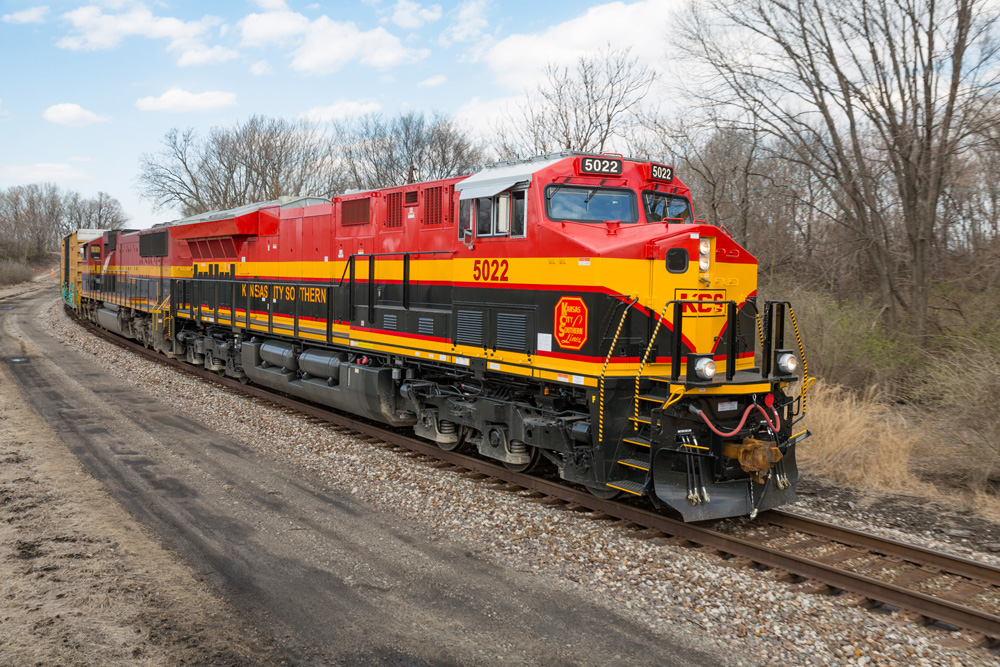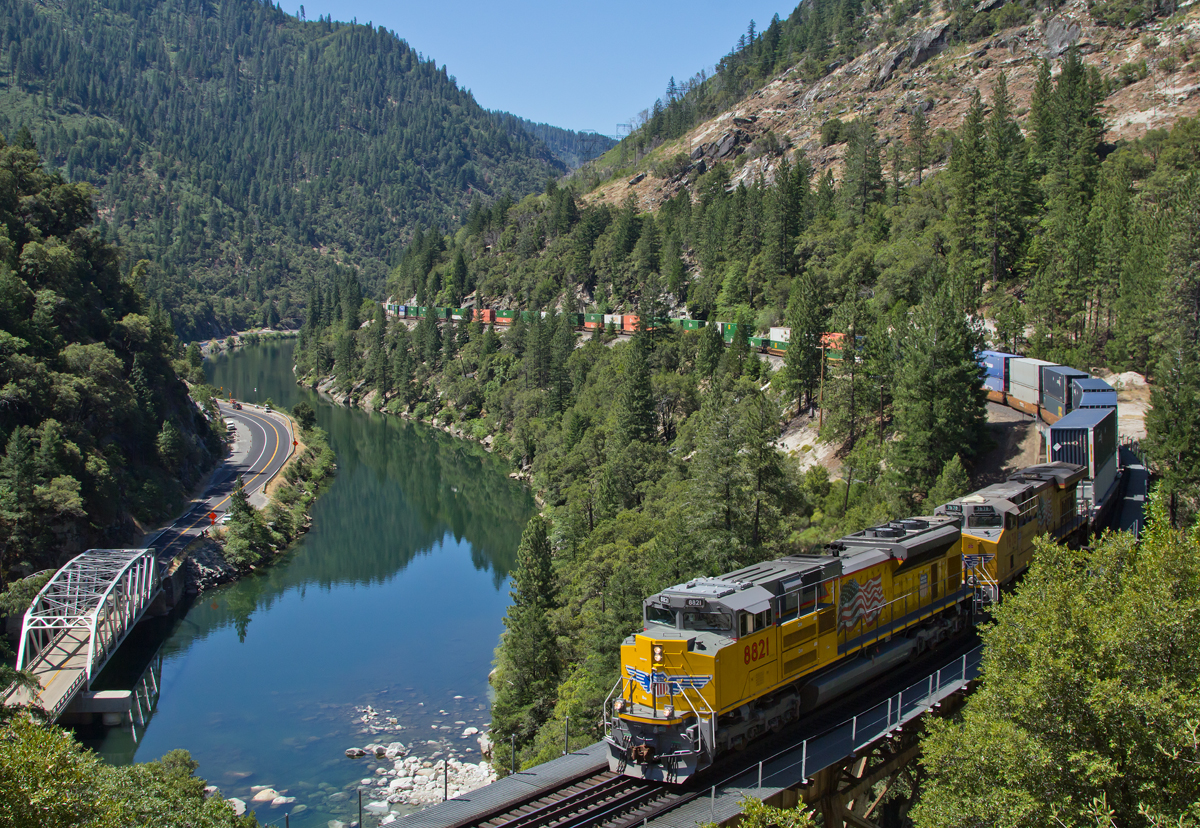
WASHINGTON — Norfolk Southern’s view of the impact of potential Amtrak service was a focal point of Wednesday’s third day of hearings on the passenger carrier’s effort to launch two daily round trips between New Orleans and Mobile, Ala.
Testifying in the Surface Transportation Board’s online hearing, Randall Hunt, the railroad’s senior director of interline services, used diagrams and drone footage to illustrate the impact on 3 miles of NS trackage, known as the “Back Belt,” connecting CSX’s Gentilly Yard and the route to the New Orleans Union Passenger Terminal.
Freight trains from six Class I railroads converge on this double-track connection, Hunt said, most of which is also used by Amtrak’s New Orleans-New York Crescent.
One-hour windows for passenger movements
“We create a window around the schedule of the Amtrak arrivals and departures for about an hour,” Hunt said. The railroad essentially stops freight traffic on that segment, he said, “and that really eats into the capacity of the railroad for about two hours every day.”
The Gulf Coast trains would require similar one-hour windows, he said: “We would be forced to stop our freight business entirely, so your operating day would be reduced from 22 hours to 18 hours or less.”
Virtually all freight trains routinely stop on this main line to change operating crews or locomotives or both, according to Hunt, when passing from CSX or NS to Union Pacific, Kansas City Southern, BNSF Railway, or Canadian National, and vice-versa. Nevertheless, he insisted, “New Orleans is running great” and the “existing operation is hunky-dory” — so none of the infrastructure projects outlined as part of the traffic modeling study on the impact of freight movements would be required if the new passenger service is not introduced.

Hunt was responding to a question from STB member Karen Hedland on whether the railroads would benefit from adding to an existing track to create a 12,000-foot “Freight Lead Extension.” This $80 million to $90 million project would allow trains to clear one of the two main trains while waiting to enter NS’ Oliver Yard. This project is in addition to 14 others costing $440 million that were recommended before the RTC modeling was rerun in November with the extension added to the mix.
The NS executive, who also serves as the railroad’s designated liaison with Amtrak, used the drone footage and track charts to show how the extension, along with additional crossovers, would allow “getting back to a base line … so we can run trains as we do today” if the new Amtrak service is added.
Modeling details still in question
Asked about specific options included in the modeling, Hunt deferred to later witnesses more closely connected with the RTC work. CSX officials who testified previously had similarly deferred on modeling details.
Other passenger projects involving NS, such as North Carolina’s Piedmont Corridor improvements and the Virginia extensions to Norfolk and Roanoke, included extensive collaboration and agreement with Amtrak and state agencies on modeling inputs, Hunt said. Amtrak, the Federal Railroad Administration, and Southern Rail Commission members argue such collaboration isn’t the case here, since variables have never been shared and basic information, such as the number of trains CSX operates over its route today, never were explicitly revealed until elicited during testimony.
STB members’ questions have focused on whether operational changes, such as possibly adjusting freight train lengths or passenger train schedules, had been tested as part of the modeling.
After Amtrak attorney Jessie Amunson asked whether such a schedule adjustment to the Crescent’s “window” was attempted, the session went into a 2-hour, 46-minute “confidential” blackout when issues deemed “proprietary” were discussed.
Such issues illustrate the challenge the STB faces in finding a solution to the current impasse.
After an off day Thursday, the fourth day of the of the hearing is set for Friday starting at 9:30 a.m. A live stream of that session will be available on the STB YouTube channel, which also includes recordings of the first three days.














Penn Station NY sees around 1000 train movements a day. You have 2 tracks from NJ, 4 from LI NY. Station has 21 platform tracks; 4 of them are stub, access from NJ only. Thru trains beyond Sunnyside Yard in Queens (must go thru East River Tubes) change crews.
If Amtrak, LIRR or NJT operates a train too long for the assigned platform, it will tie up one or more of the interlockings and block movements into or out of the station. This can be done but it must be precisely schedulled.
RDG and CNJ used to change crews in Allentown Yard, leaving the main tracks free for other movements. They had relay tracks for this purpose, as did other roads doing the same.
That’s what CSX and NS need: a yard or relay tracks commensurate with the length and number of the current and future megatrains.
Too bad the accompanying map isn’t a thumbnail.
“After Amtrak attorney Jessie Amunson asked whether such a schedule adjustment to the Crescent’s “window” was attempted, the session went into a 2-hour, 46-minute “confidential” blackout when issues deemed “proprietary” were discussed.”
So go hire a traffic observer and create a model from the traffic observed by them and input it. I laugh when I hear about this “proprietary” stuff, when people can watch yard operations and listen to the dispatchers and crew on their radios. It means anyone can chart operations.
The only thing “proprietary” is when an engineer stops a consist in transit so he can jump down and pick up some fried chicken from the nearby take out stand but tells the dispatcher they need to do an air brake check.
What the railroads are worried about is that their operational decisions will be audited and therefore second guessed. No one wants an armchair dispatcher looking over their shoulder.
Spot on, John. Railroad operations are no mystery to any casual observer, and management’s view that this information is somehow top secret is downright laughable.
“New Orleans is running great” and the “existing operation is hunky-dory” — so none of the infrastructure projects outlined as part of the traffic modeling study on the impact of freight movements would be required if the new passenger service is not introduced.” If it’s running so great why is there a backlog for years in that area. Seems the Class 1’s that use that area should have expanded that 3rd track years ago when they knew they would be going to greater train lengths. Now they want someone else to pay (taxpayers) so their shareholders still see profits. BOO HOO NS.
Everyone talks about the volume of traffic through Chicago. Vast majority of people don’t realize that 10-12% of “all” US rail traffic passes through New Orleans and that 90% of that volume uses this stretch of track.
This is narrow section is like an hour glass. You have UP & BNSF yards on the west bank of river and crosses the Huey P. Long bridge. You have CN (ex IC) and KCS yards west of the city. These 4 railroads are shuttling their trains east to the CSX & NS which are on that side of the city. Then you have NS & CSX shuttling their cars the opposite way west to the other 4. So this one I get.
Every time I pass this segment of track (it runs parallel to I-610 thru New Orleans for most of it’s length), 2 or more trains are occupying one or both tracks. It is rare (like once in a blue moon) that I don’t see at least one train on this segment I had wondered why the hadn’t triple tracked it years ago. To widen this short segment would be somewhat expensive.. While little or no additional right of way would be needed. at least 5 existing street underpasses would need rebuilding or widening and 2 existing overpasses may need extending or modifying.
Yes, lots of traffic, but it was revealed that all trains must change crews on this crucial stretch of track as NS and CSX are not authorized to operate over the Long bridge. Chairman asked if they considered changing this; short answer, no. Then all discussion of operations was stricken from STB consideration as the witness was only supposed to talk about facilities. What a charade.
Simple solution, since the Huey P Long bridge is owned by the New Orleans Public Belt…order CSX and NS to negotiate access to the bridge with NOPB, and if they can’t come to a mutual arrangement, then first try mediation, if that doesn’t work, then send it to arbitration.
The statement that they think that a one-hour window for each passenger train must be created proves that management knows nothing about how to run an efficient operation. It’s simply sloppy.
My thoughts too 🙁
Glasgow to Edinburgh Scotland
Average 84 passenger trains each day, each way
And only runs from 05:40 to 23:40
Interestingly, CSX & NS counsel have formally filed a memo to the STB an objecting to the nature of the board’s interrogation of a witness:
“Pursuant to the colloquy with the Surface Transportation Board (“Board”) during the evidentiary hearing on the morning of April 5, 2022, CSX Transportation, Inc. (“CSXT”) and Norfolk Southern Railway Company (“NSR”) respectfully file this memorandum to supplement the record regarding their objection1 to the tenor and form of the Board’s cross-examination of witness Charlie Banks on April 4 and April 5, 2022, and to expand on the principles providing parameters regarding the judicial role during a hearing on the record.”
https://dcms-external.s3.amazonaws.com/DCMS_External_PROD/1649272823900/304250.pdf
Hilarious when you look to Europe and Asia and how passenger and freight trains operate on the same track in short windows between trains. Of course, they have the infrastructure which is state-owned and maintained, over fifty years of operating experience of mix freight and fast passenger trains, and their freight trains are not miles long.